You found our list of top employee experience books.
Employee experience books are guides that emphasize putting staff’s feelings, perceptions, and sensations at the center of management decisions. These works cover topics like psychological safety, community, management, and company culture. The purpose of these books is to help leaders build better work environments and improve the odds of recruitment and employee retainment. Employee experience is sometimes called EX.
These works are a subset of HR books and are similar to employee engagement books and company culture books.
This list includes:
- books on employee experience
- books on people strategy
- employee experience strategy books
- workplace experience books
Here we go!
List of employee experience books
Here is a list of bestselling employee experience books meant to make the workplace more meaningful and enjoyable for team members.
1. The Employee Experience Advantage: How to Win the War for Talent by Giving Employees the Workspaces they Want, the Tools they Need, and a Culture They Can Celebrate by Jacob Morgan
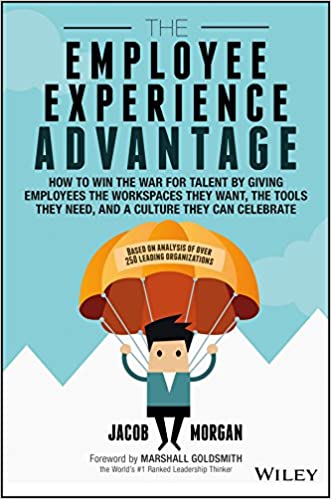
The Employee Experience Advantage is one of the best books on employee experience. Tapping into studies of over 250 companies and interviews with over 150 executives, Jacob Morgan identifies the factors that make team members excited to come to work and do their jobs.
The book breaks down the concept into core components like the physical, technical, and cultural environments, and gives leaders a toolkit to design and measure employee experience. Later chapters explain detailed techniques, frameworks, and exercises for building experiential organizations and contain case studies that model successful practices. The book lays out the building blocks and small steps that turn organizations into great places to work.
The text also touches on the business benefits of creating positive atmospheres for staff, such as an edge in recruitment, improved customer service, increased innovation, and reputable employer brands. The Employee Experience Advantage serves as the definitive guide to workplace experience and gives leaders a blueprint to follow to turn team members into dedicated fans.
Notable Quote: “Bonuses don’t really motivate workers. Once they reach a certain baseline salary, money is no longer the main driver. They need something more. Reams have been written about the Millennial generation’s hunt for impact and meaning at work. In one way, I think Millennials (and Generation Z) are not so different from the rest of us. They just voice the desires the rest of us have learned to keep quiet.”
Read The Employee Experience Advantage.
2. I Love It Here: How Great Leaders Create Organizations Their People Never Want to Leave by Clint Pulver

I Love It Here is the ultimate guide to creating a workplace employees actually enjoy. Author Clint Pulver shares insights he learned from his “Undercover Millennial” project, where he posed as a prospective applicant to learn how employees really felt about their jobs and companies. The answers often showed a disconnect between employer and employee opinions about the quality of the workplace. This book mines that research to spotlight the patterns of happy workplaces and the elements most critical to positive employee experience. Chapters speak to topics such as mentorship, professional development, autonomy, and personal growth. I Love It Here is a book on employee experience drawn from the employee perspective. The book provides tools and tips leaders can use to turn jobs into great jobs.
Notable Quote: “If you want to create lasting, meaningful change, you have to talk about solutions.”
Read I Love It Here.
Want some free team building tools?
$49 value (100% free)
- 100+ fully tested icebreaker questions
- 24+ themed Bingo generators
- 5+ PDFs (including the 8% Rule)
- 2024 team building calendar
- and more...

Enter your email for instant access
3. The Employee Experience: How to Attract Talent, Retain Top Performers, and Drive Results by Matthew Wride and Tracy Maylett
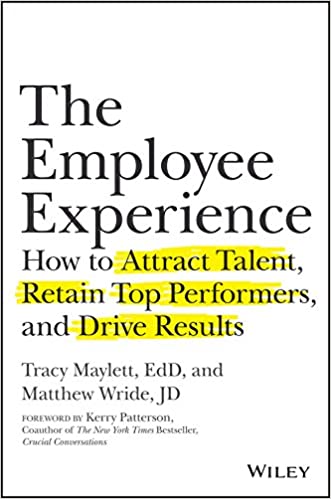
The Employee Experience is one of the most useful employee experience strategy books. This guide compares employee experience with customer experience and shows how the two concepts connect. The book also explains how the practice of this theory can lead to organizational growth and profit. The authors present the idea of employers making a “contract” with employees and building trust by fulfilling those promises. The book also urges leaders to be aware of and address team member expectations to ensure that boss’ and teammates’ ideas of a good workplace align. The Employee Experience preaches that treating employees with respect and giving them the tools, confidence, and freedom to do their best work is the best way to deliver extraordinary business results
Notable Quote: “Your employees are the soil and nutrients in which your Customer Experience grows. If you have a workforce of engaged people who feel respected and appreciated, and if they trust their leaders enough to take risks and invest emotionally in the organization, your CX will take care of itself.”
Read The Employee Experience.
4. People Operations: Automate HR, Design a Great Employee Experience, and Unleash Your Workforce by Jay Fulcher, Kevin Marasco, and Tracy Cote
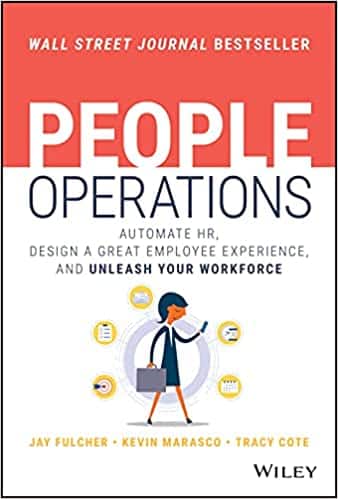
People Operations is one of the more helpful books on people strategy. This guide shows HR professionals how to use software to automate departmental processes and “busywork” so that they can focus on optimizing human capital and creating better experiences for employees. The first part of the book explains and explores the methodology of People Ops, an employee-centric model of organizational operation. Next, the authors show how technology such as payroll automation and benefits administration platforms can improve the employee experience. Finally, the book hones in on the interactive elements of workplace experience such as communication, team building, performance alignment, and employee motivation. People Operations provides a practical blueprint for streamlining effort into the areas that matter most to employees and that make the biggest impact on culture and performance.
Notable Quote: “When you empower your people to do their best every day, you build a more resilient culture that becomes a sustainable competitive advantage.”
Read People Operations, and check out this list of tools and apps for HR professionals.
5. How to Be a Great Boss by Gino Wickman and René Boer
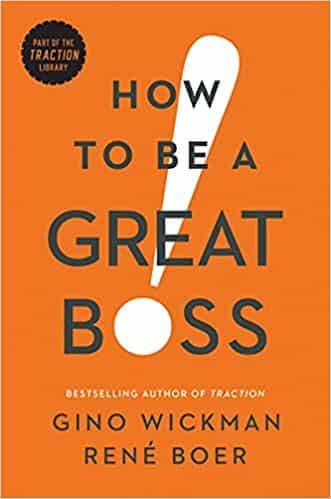
Management is a major part of the employee experience. A popular saying goes, “people do not leave bad jobs, they leave bad managers.” How to Be a Great Boss explains how to create a wonderful work environment and bring out the best in employees. The book explains the difference between leadership and management, points out best practices of great bosses, and shows how to form relationships with team members. The text also touches on how to foster accountability and deal with performance issues constructively. How to Be a Great Boss is full of practical leadership tips that minimize frustration and boost excitement and motivation in employees. The book stresses that the ultimate goal of effective leadership is to help employees have positive relationships with bosses and coworkers and a sense that their work is meaningful and impactful.
Notable Quote: “We’re facing a crisis that is not just measured by a lack of opportunity for the workforce, but also by the lack of enthusiasm that the workforce has for their jobs. We’re losing our competitive advantage….You need an engaged, raring-to-go workforce. Your choices are to lead, follow, or get out of the way. You must decide.”
Read How to Be a Great Boss, and check out more books on management and this list of signs of a good boss.
6. Love as a Business Strategy: Resilience, Belonging & Success by Mohammad F. Anwar, Frank E. Danna, Jeffrey F. Ma, et al.
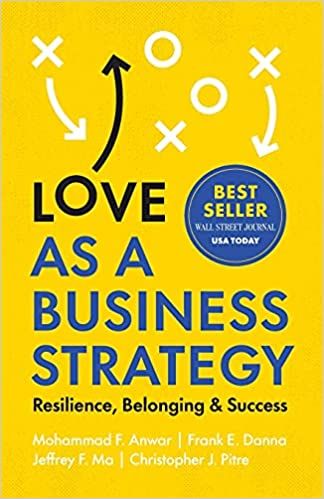
Love as a Business Strategy advocates for compassionate and empathetic leadership. The book opens with the story of the authors leading layoffs at their software company in a rather cold, “businesslike” manner as advised. Feeling that this approach was unfair to employees and harmful to the business long term, the leaders vowed to practice more “loving” leadership. The book encourages leaders to embrace traits like empathy, forgiveness, trust, and vulnerability, and shows how removing fear and empowering employees sets team members up to do their best work and benefits the business in the present and future. Love as a Business Strategy shows leaders ways to work humanity into management without losing authority or accountability and improve the employee experience in the process.
Notable Quote: “For anyone who has lived in fear, you know that it is unpleasant at best and debilitating at its worst. When fear is present, there is no room for growth and maturity– you are simply trying to make it through the day. When you are able to let your guard down, that is where the magic happens. Those are the times when you are able to push beyond what you know you can do and accomplish things you never thought were possible.”
Read Love as a Business Strategy: Resilience, Belonging & Success.
7. Catalysts of Culture – How Visionary Leaders Activate the Employee Experience by Julie Ann Sullivan
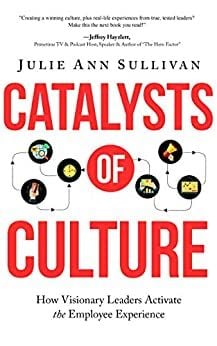
Catalysts of Culture is one of the best workplace experience books. Julie Ann Sullivan interviewed leaders from companies like Anytime Fitness, WD-40, and SHRM. This anthology shares interviewee’s words of wisdom on creating thriving workplaces that motivate and empower employees. Each interview focuses on a topic such as servant leadership, relationship building, positive reinforcement, and transparency. Together, the interviews help readers discover patterns within organizations with exceptional employee-first cultures and uncover actionable advice for recreating these types of environments and results. Catalysts of Culture is full of valuable insights from employee experience experts as well as case studies and research, and touches on the most important topics and questions within the realm of workplace experience.
Notable Quote: “The employee experience starts when someone sees a job that you’re offering. How is it written? What’s in it for them? What do they see that would make them say, “I want to work there.”
Read Catalysts of Culture.
8. The 4 Stages of Psychological Safety: Defining the Path to Inclusion and Innovation by Timothy R. Clark
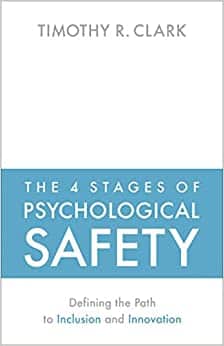
Psychological safety is one of the most critical components of positive workplace experience. The 4 Stages of Psychological Safety presents a masterclass in how to create this condition within your organization. The book breaks down psychological safety into four phases: inclusion, learning, contributing, and challenging. The more safe and respected employees feel, the more they are willing to grow, take risks, share ideas, and give extra effort. Timothy R Clark supports his theories with firsthand experience as a CEO and consultant, as well as psychological, social, and philosophical principles. The book shows leaders how to banish fear, enable growth, and guide team members’ development in ways that enhance employee performance and boost staff morale.
Notable Quote: “In our social units, we should create an environment of inclusion before we begin to think about judgments at all. Worth precedes worthiness. There’s a time and a place to judge worthiness, but when you allow someone to cross the threshold of inclusion, there’s no litmus test.”
Read The 4 Stages of Psychological Safety, and check out more books on inclusion and organizational behavior.
9. The Art of Community: Seven Principles for Belonging by Charles Vogl
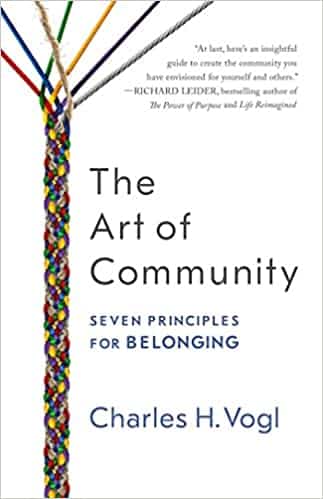
The Art of Community is a manual for cultivating a sense of belonging and shared purpose among groups. The book does not focus exclusively on work, and instead provides a set of more general guidelines and best practices for forming community. The author highlights seven key practices for building strong communities such as rituals and storytelling, and gives leaders tools to use to foster connection, inclusivity, and unity among the group. The book contains valuable tips applicable to team building, forming work friendships, and creating cohesive work friendships. Getting along with coworkers undoubtedly improves the employee experience, to the extent that having work friends makes professionals less likely to leave jobs. The Art of Community gives leaders the power to turn workplaces into gathering places and make employees feel like a part of something significant.
Notable Quote: “To create something that others want to join and support, we have to remember a core tenet: communities function best and are most durable when they’re helping members to be more successful in some way in a connected and dynamic world. If you forget this, or even worse, if you never understand this, then your efforts will be misplaced.”
Read The Art of Community, and check out this list of community building exercises.
10. Employee Experience: Develop a Happy, Productive and Supported Workforce for Exceptional Individual and Business Performance by Ben Whitter

Ben Whitter’s Employee Experience is a crash course in EX. The author challenges readers to think of EX as a responsibility of all organizational leaders rather than just a function of HR. Ben Whitter lays out a system he calls Holistic Employee Experience that weaves understanding, respect, and support for employees through all areas of the organization. This approach serves as a starting point for leaders to develop employee-first organizations full of loyal, highly motivated, high-achieving employees. The book is full of case studies and examples that show these theories in practice.
Notable Quote: “Where does the company stand when you are at your best? Where does the company stand when you are at your worst? It is these moments that define the future relationship with an employer.”
Read Employee Experience.
11. The Employee Experience Solution: Transform Employee Engagement, Improve Workplace Culture, and Drive Results by Melissa Anzman
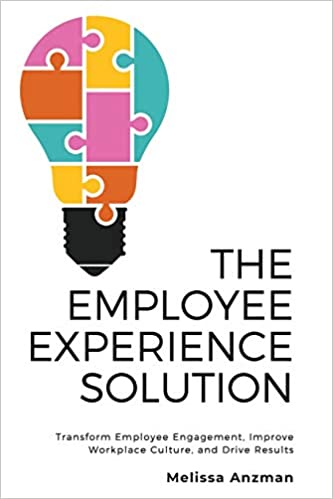
The Employee Experience Solution is one of the most useful employee experience strategy books. The book provides clear frameworks and actionable steps to creating more employee-centric work cultures. Melissa Anzman suggests techniques for attracting talent, improving internal communications, building a sought-after work culture, and engaging employees in meaningful and measurable ways. The end goal of these actions is not only to improve employee’s experience, but also to boost the business’s bottom line and achieve long lasting results. The Employee Experience Solution hits on the basic points of EX and gives leaders a practical plan to follow to achieve organizational harmony.
Notable Quote: “In today’s multigenerational workforce, the need for customized or configurable experiences is the only way we can effectively capture each generation’s attention. In the past, we have provided a standard one-size-fits-all experience– and our employees realigned their personal preferences to “get on board.” Employees no longer feel the need to conform in this way. They want an experience that matches their preferences and will go to great lengths to achieve it.”
Read The Employee Experience Solution.
12. The Future Workplace Experience: 10 Rules For Mastering Disruption in Recruiting and Engaging Employees by Jeanne Meister and Kevin Mulcahy
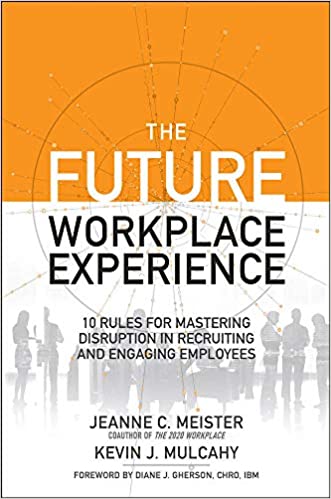
The Future Workplace Experience makes the argument that employee experience is more than a passing fad and is likely to become the standard business practice of tomorrow. The book focuses on three key areas: worker expectations, technology’s effect on the workplace, and shifting workforce demographics. This guide explains the way that the work world is changing and provides advice on how leaders, recruiters, managers, and HR pros can adapt to and embrace these changes.
The book lays out a framework for building and maintaining strong employee cultures despite disruption through methods such as enabling on-demand learning, relying on data to recruit, preparing for increases in gig workers, and pushing for more fair and equitable workplaces. The Future Workplace Experience takes a proactive approach to EX by imagining the accommodations the workforce will need in the near future as well as the demands of the present.
Notable Quote: “HR needs to focus more on creating one seamless experience that is memorable and compelling and connects to the individual employee on an emotional level.”
Read The Future Workplace Experience.
Final Thoughts
Employee experience is a misunderstood and often misused term. Many folks confuse it with employee engagement. However, employee experience is a more comprehensive concept that includes engagement, yet also encompasses other elements of workers’ wellbeing and perceptions of the job. Some bosses mistakenly think that workplace experience is about providing free snacks or ping pong tables or massages. While these perks can contribute to a more pleasant working environment, the heart of employee experience is non-material factors like relationships with teammates, structure and accountability, meaningful work, access to tools and resources, support and respect from bosses, and company culture and values.
Books on employee experience give leaders a deeper understanding of what employee experience entails and lay out actionable steps to making companies great places to work. These guides highlight the business benefits of taking employees’ feelings and needs into account in the decision making process, and make it clear that employee experience is not a passing fad, but rather, the future of work. Reading these books equips leaders to satisfy the demands of the workforce and create companies that folks want to work for.
For more reading recommendations, check out this list of Employee Appreciation Day ideas, these virtual staff appreciation ideas, and this list of employee appreciation quotes.
We also have a list of customer experience books.
